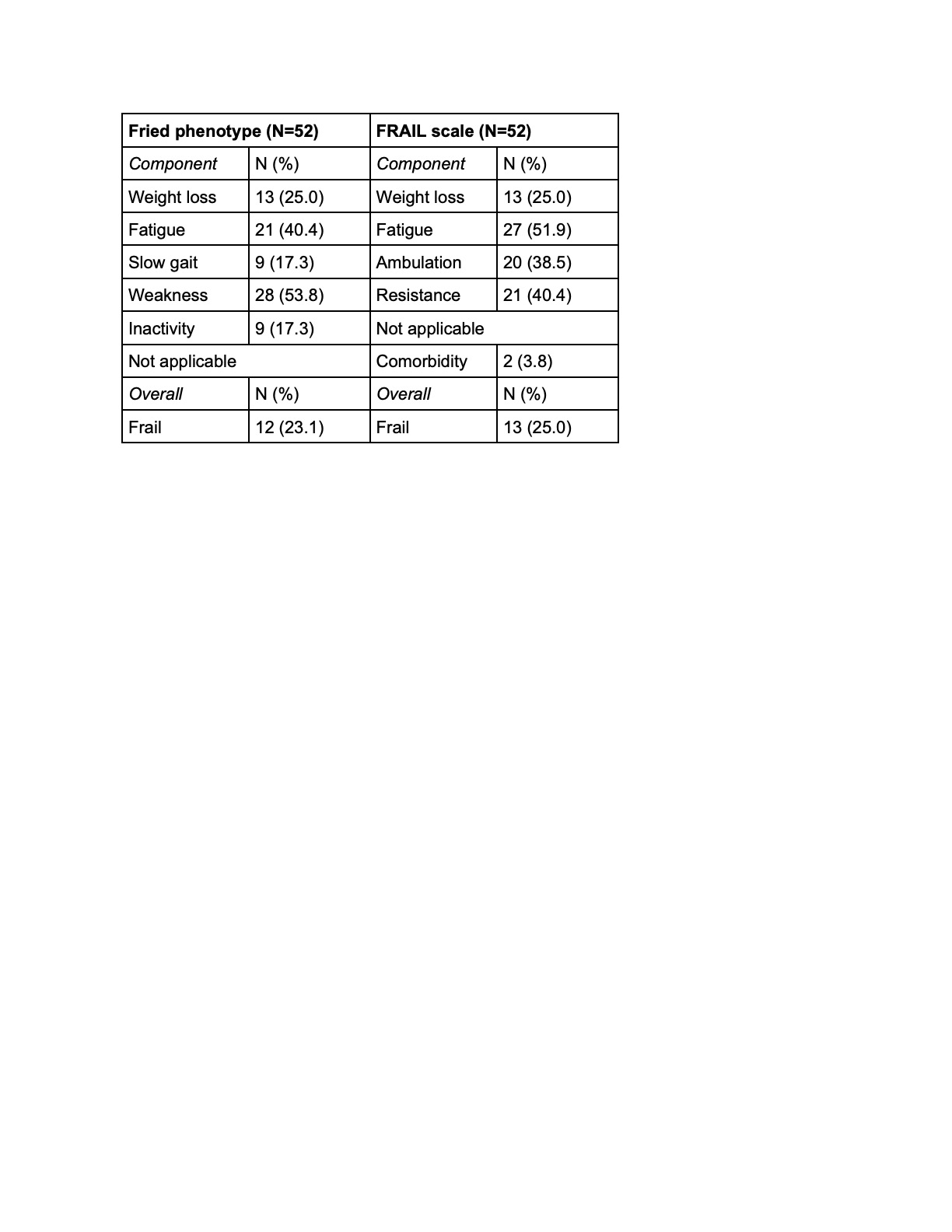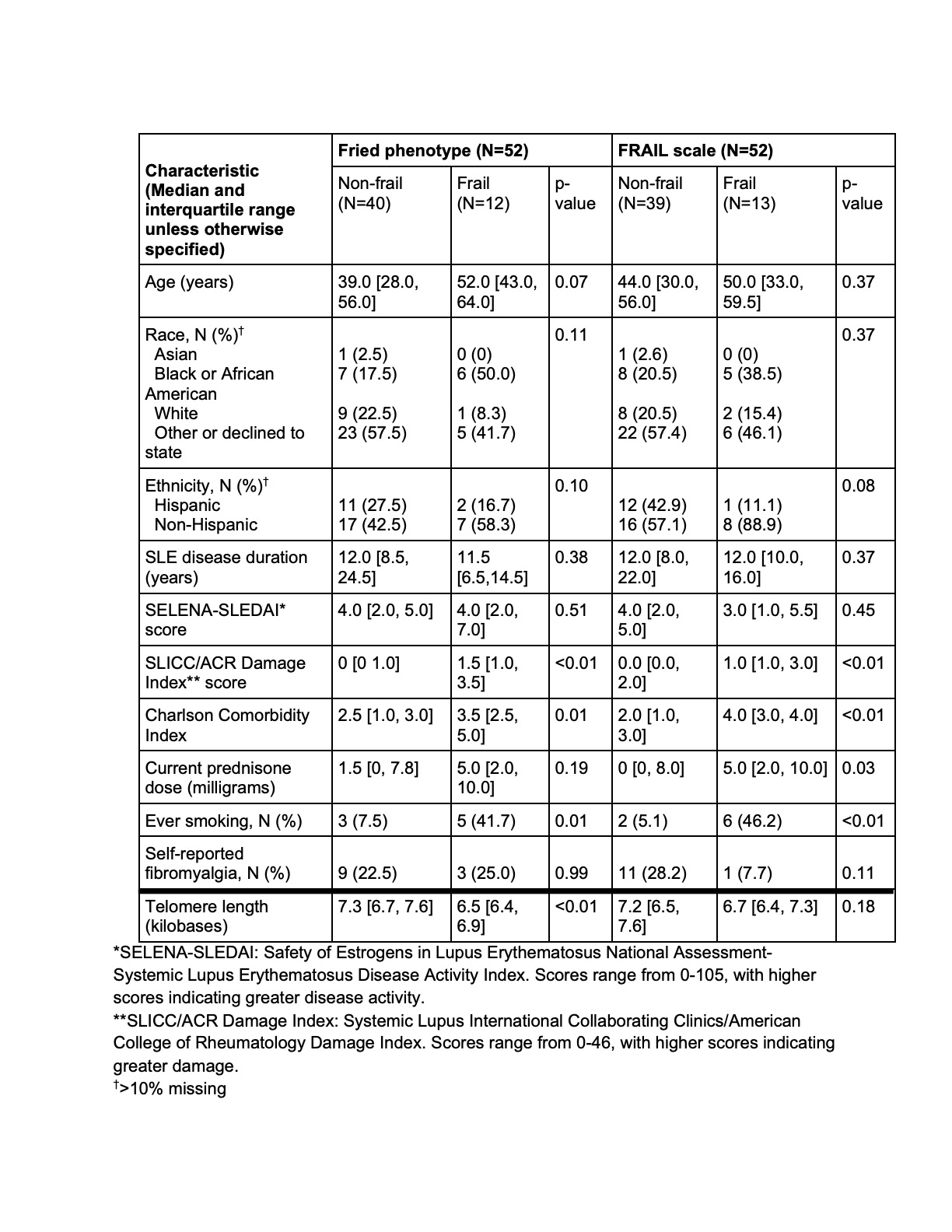Session Information
Date: Sunday, November 7, 2021
Title: SLE – Diagnosis, Manifestations, & Outcomes Poster II: Manifestations (0855–0896)
Session Type: Poster Session B
Session Time: 8:30AM-10:30AM
Background/Purpose: Frailty is a novel risk factor for adverse health outcomes in systemic lupus erythematosus (SLE). Although frailly is conceptualized as “accelerated aging,” whether the frailty phenotype is associated with physiologic biomarkers of aging is unclear. Shortened telomere length reflects cellular senescence in older adults. Although preliminary evidence suggests that telomere length is not associated with a SLE-specific cumulative deficits definition of frailty in adult women with SLE [1], to our knowledge, the relationship between telomere length and phenotypic definitions of frailty has not been assessed in women with SLE. We aimed to evaluate differences in telomere length between frail and non-frail women with SLE and to assess whether telomere length is independently associated with frailty after controlling for multiple potential confounders.
Methods: Women ≥18 years old with SLE validated according to the 2019 European League Against Rheumatism/American College of Rheumatology Classification Criteria were enrolled at a single center. Frailty status according to both the Fried phenotype (FP), which includes objective and self-report components, and the FRAIL scale (FS), an exclusively self-report instrument, were measured at a single study visit. Telomere length was determined from whole blood drawn at the same visit using Southern analysis of terminal restriction fragments. Sociodemographic features and physician-reported disease activity and damage also were collected. Differences between frail and non-frail participants were evaluated using Fisher’s exact or Wilcoxon rank sum tests. The association of telomere length with frailty was assessed using logistic regression.
Results: Data from 52 participants were available for this interim analysis. 12 (23.1%) and 13 (25.0%) of women were classified as frail according to the FP and the FS, respectively, despite median age of 50-52 years old (Tables 1 and 2). Frail women according to both metrics had greater comorbidity burden (FP: p=0.01; FS: p< 0.01), more organ damage (FP: p< 0.01; FS: p< 0.01), and a higher prevalence of cigarette smoking (FP: p=0.01; FS: p< 0.01) than non-frail women; frail women according to the FS also were taking more glucocorticoids compared to non-frail women (p=0.03) (Table 2). Telomere length was significantly shorter among frail versus non-frail women according to the FP (p< 0.01), but not the FS (p=0.18) (Table 2). Similarly, telomere length was significantly associated with frailty according to the FP (Odds ratio [OR] 0.19, 95% confidence interval [CI] 0.06-0.65), but not the FS. This relationship was attenuated for the FP after adjustment for age (OR 0.26, 95% CI 0.07-0.96) and further attenuated after adjustment for organ damage (OR 0.21, 95% CI 0.04-1.03) (Table 3).
Conclusion: Approximately a quarter of women with SLE were frail according to two validated frailty measures. Shorter telomere length was associated with frailty according to the FP, but not the FS, suggesting that the FP is a better measure of accelerated aging in women with SLE. Further study is needed to identify the longitudinal impact of frailty on the health of women with SLE.
Reference:
1. Lima K et al. Arthritis Rheumatol 2020;72(suppl 10).
To cite this abstract in AMA style:
Lieber S, Lipschultz R, Zahid S, Rajan M, Lin M, Donlin L, Lue N, Mandl L. Association of Telomere Length with Phenotypic Frailty in Systemic Lupus Erythematosus [abstract]. Arthritis Rheumatol. 2021; 73 (suppl 9). https://acrabstracts.org/abstract/association-of-telomere-length-with-phenotypic-frailty-in-systemic-lupus-erythematosus/. Accessed .« Back to ACR Convergence 2021
ACR Meeting Abstracts - https://acrabstracts.org/abstract/association-of-telomere-length-with-phenotypic-frailty-in-systemic-lupus-erythematosus/



